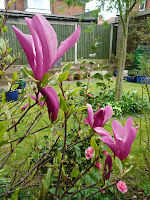The lovely warm weather has resulted in a spectacular display of spring flowers and blossom in the garden. On my weeping cherry tree (Prunus 'Kiku-shidare Sakura') the gracefully drooping branches were weighed down by beautiful double pink flowers during the first half of April. At the same time my evergreen Camellia produced its lovely dark pink flowers. I was worried that the Camellia may have had its flower buds damaged by frost and would not flower well this year, but it proved me wrong with a wonderful display.
Just as the cherry blossom and camellia flowers were fading, my dwarf rhododendron 'Scarlet Wonder' burst into colour with the whole plant covered in gorgeous deep red flowers. This is one plant which certainly lives up to its name! I grow it in a large glazed pot using ericaceous compost as it prefers acid soil. My garden soil is fairly neutral but not acid and the camellia seems to be thriving here even though they normally favour a more acid soil. I have planted it in the shelter of more mature shrubs to protect it from cold winds.
Another spring favourite is the Magnolia x Soulangiana 'Susan' which produces pink-purple flowers 3-4 inches across in April. Unfortunately, like the camellia and cherry tree, the flowers are quite short-lived. But it is still worth growing all these plants for the sheer beauty of their flowers.
If you are in Cumbria it is well worth paying a visit to Muncaster Castle to see the amazing display of all kinds of rhododendrons and azaleas lining the quarter mile driveway leading to the castle. There is also a wonderful display of spring flowering magnolias, cherries, pieris and rhododendrons on the inner side of the castle's terraced walk.
Wednesday, 27 April 2011
Tuesday, 12 April 2011
Gardening in Madeira
I have just returned from a holiday on the beautiful island of Madeira which is an interesting place for anyone who loves gardens and gardening.
There are lovely parks and botanical gardens to visit but the gardens I found most fascinating were the private gardens of houses built on the steep hillsides and mountainsides of this volcanic island. These mainly small gardens are steeply terraced and every inch of the land is put to good use. It is certainly a lot more challenging than gardening in England but they do have the advantage with the climate. A lot of the gardens are used to grow food but areas near to the house often have beautiful displays of flowers.
Flowers seem to be everywhere you look on this island. Azaleas in a riot of different colours hang over walls and steep embankments. Nasturtiums tumble wildly down the hillsides and the lovely Bird of Paradise flower (pictured above) grows everywhere, in gardens and along the roadside verges. Water is transported from the wetter west and northwest of the island to the drier southeast by way of irrigation channels called levadas. Levada walks are very popular with visitors.
I would love to go there again at a different time of the year to see the gardens in full flower.
There are lovely parks and botanical gardens to visit but the gardens I found most fascinating were the private gardens of houses built on the steep hillsides and mountainsides of this volcanic island. These mainly small gardens are steeply terraced and every inch of the land is put to good use. It is certainly a lot more challenging than gardening in England but they do have the advantage with the climate. A lot of the gardens are used to grow food but areas near to the house often have beautiful displays of flowers.
Flowers seem to be everywhere you look on this island. Azaleas in a riot of different colours hang over walls and steep embankments. Nasturtiums tumble wildly down the hillsides and the lovely Bird of Paradise flower (pictured above) grows everywhere, in gardens and along the roadside verges. Water is transported from the wetter west and northwest of the island to the drier southeast by way of irrigation channels called levadas. Levada walks are very popular with visitors.
I would love to go there again at a different time of the year to see the gardens in full flower.
Subscribe to:
Comments (Atom)



